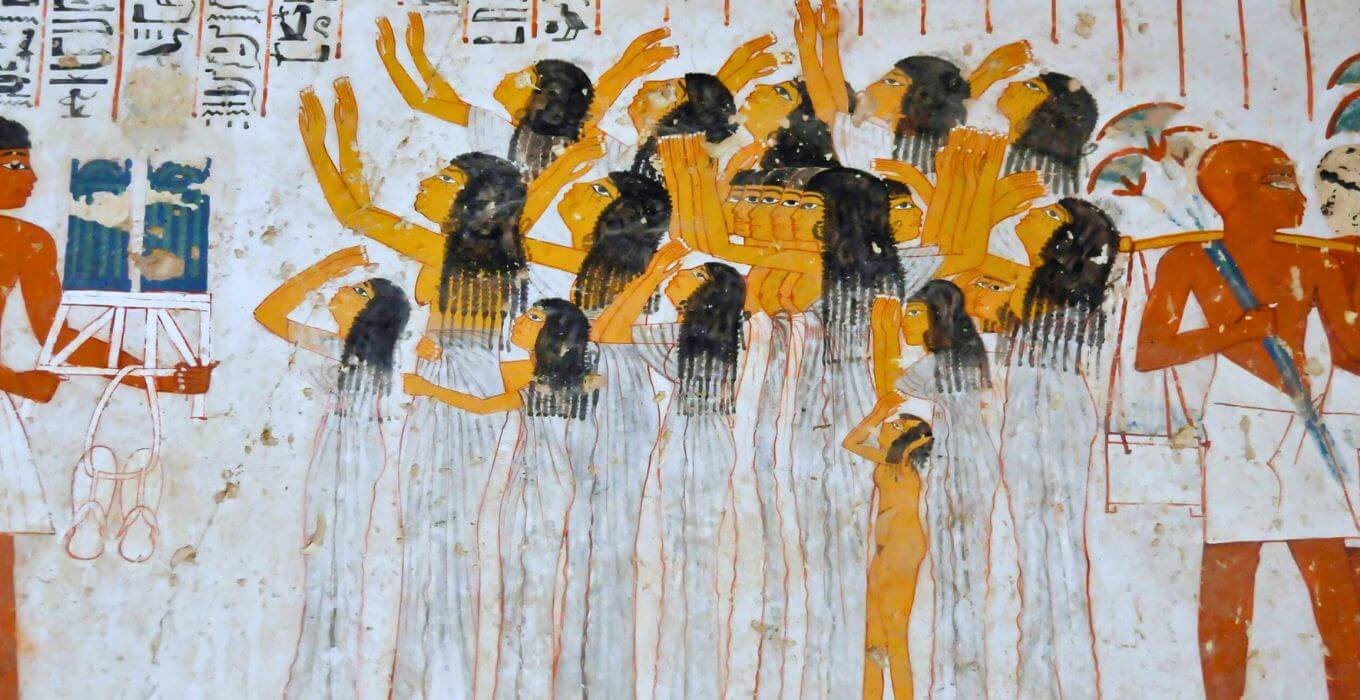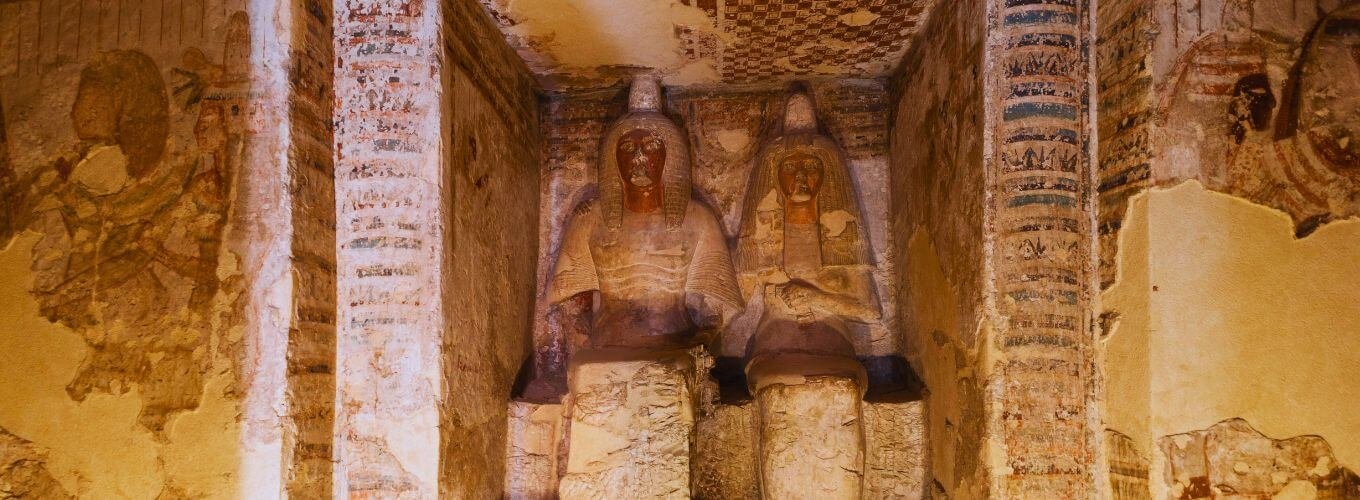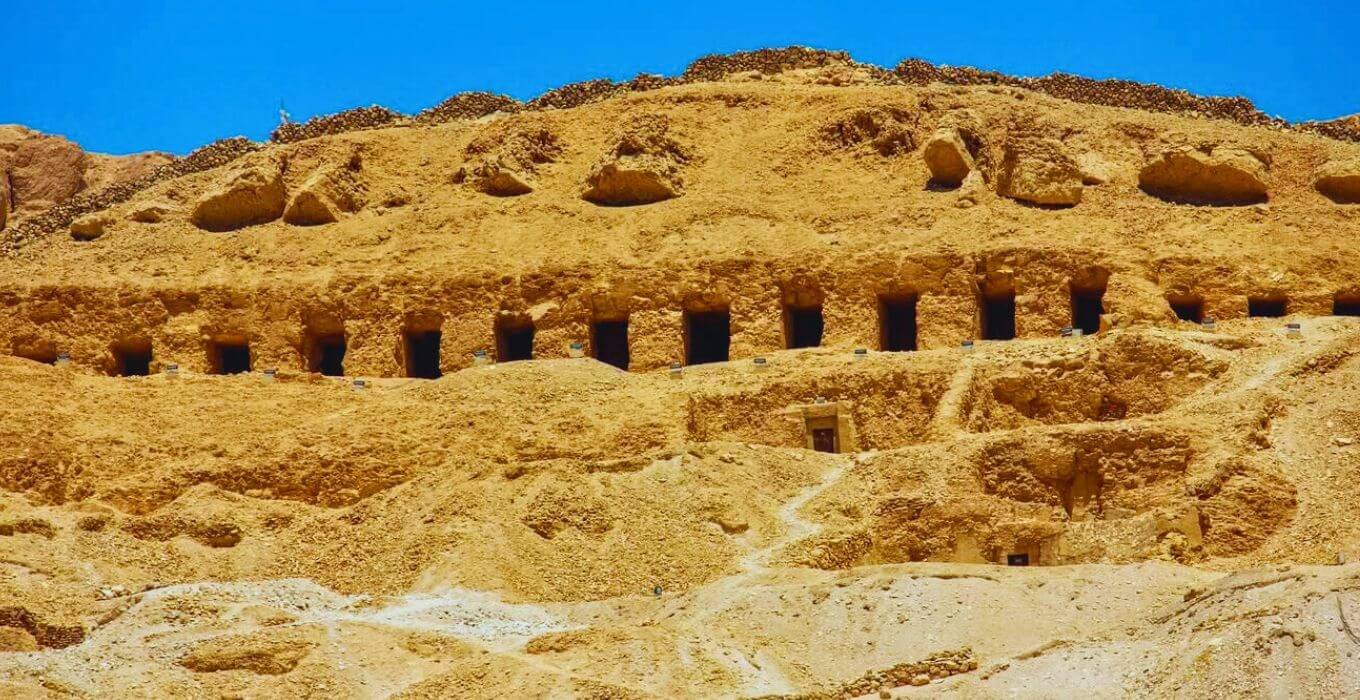In the foothills opposite the Ramesseum on Luxor‘s West Bank, a treasure trove of ancient Egyptian history awaits. The Tombs of the Nobles hold secrets worth exploring. These lesser-known sites reveal the lives of ancient Egypt’s elite in vivid detail.
These tombs belong to administrators, governors, and other minor nobility figures. They offer a unique look into life in ancient Egypt, often overshadowed by grand royal tombs. With over 400 tombs spanning from the 6th dynasty to the Graeco-Roman period, the Valley of the Nobles is a window into the daily lives of the elite.
What secrets do these tombs hold, and how do they differ from royal burial sites? Join us as we explore the Tombs of the Nobles and uncover their captivating stories.
Key Takeaways
- The Tombs of the Nobles in Luxor offer a unique perspective on ancient Egyptian life, showcasing the daily concerns and occupations of the elite class.
- These tombs receive fewer visitors compared to the more famous royal tombs and temple complexes, making them a hidden gem for those seeking a more authentic and intimate encounter with Egypt’s cultural heritage.
- The Tombs of the Nobles feature detailed wall paintings and reliefs that depict scenes of everyday life, providing a stark contrast to the more symbolic and repetitive imagery found in the royal tombs.
- Navigating the Tombs of the Nobles can be challenging, as they often lack prominent markings and require the assistance of a guide to fully appreciate their significance.
- The Valley of the Nobles contains a wealth of archaeological treasures, with ongoing discoveries shedding new light on the lives and legacies of ancient Egypt’s elite class.
The Tombs of The Nobles in Luxor
Overview of the Necropolis’ Location and Significance
The Tombs of the Nobles are located on Luxor’s West Bank. They are between the Ramesseum and Hatshepsut’s Temple. This necropolis shows the lives of ancient Egyptian administrators and governors.
Unlike royal tombs, these tombs show everyday life. They depict the jobs of important officials. This makes them special.
The Valley of the Nobles has about 415 tombs from the New Kingdom period. It’s a key part of Luxor’s history. Visitors can see the tombs of governors, priests, and even kings.
The lower part of the necropolis has tombs of employees and laborers. It’s a chance to see the lives of those who worked hard.
|
Tomb |
Owner |
Significance |
|
TT 55 |
Ra-Mose |
Mayor of Thebes during the reign of Amenhotep III and Akhenaten |
|
TT 83 |
Aametju (Ahmosis) |
Mayor of Thebes and Vizier under Thutmose III of the 18th Dynasty |
|
TT 82 |
Amenemhat |
Steward of the Vizier and scribe under Thutmosis III, who reused the Pyramid Texts of the Old Kingdom |
The Tombs of the Nobles in Luxor give us a peek into the lives of ancient officials. They offer a unique view of ancient Egyptian society.

Discovering the Lesser-Known Treasures
In the Tombs of The Nobles in Luxor’s Necropolis, you’ll find treasures not many see. While the Valley of the Kings gets most of the visitors, these spots offer a closer look at ancient Egyptian life. They show what daily life was like for the elite.
The Tombs of The Nobles are tucked away in the Valley of the Nobles. They’re not as famous as the royal tombs, so you’ll find fewer people here. This makes for a more personal and exciting visit. But, you might need a guide to find your way around.
To see these tombs, you need a special ticket from the West Bank ticket office. It’s a bit more work, but it’s worth it. These hidden spots reveal the lives of ancient nobles, from officials to farmers.
|
Tomb |
Highlights |
|
Tomb of Rekhmire |
Exquisite reliefs and court scenes depicting the daily activities of the ancient Egyptian elite |
|
Tomb of Ramose |
A masterpiece of 18th Dynasty art, showcasing the remarkable skills of ancient Egyptian artists |
|
Tomb of Sennefer |
The vine-covered ceiling, a unique and breathtaking feature that sets this tomb apart |
These hidden Tombs of The Nobles in Luxor’s Necropolis are a unique adventure. They’re perfect for those wanting to explore the Archaeological Wonders and Egyptian Antiquities beyond the usual tourist spots.
Tombs of The Nobles in Luxor: A Window into Daily Life
The grand tombs and temples of Egypt are famous, but the Tombs of the Nobles in Luxor show a different side. They give us a peek into the lives of the ancient Egyptian elite. These hidden gems contrast with the grand images of pharaohs, revealing the culture and art of Egypt’s administrative class.
Contrasting with Royal Tombs and Temples
The Tombs of the Nobles are simpler and more relatable than royal tombs. They show scenes of everyday life, like farming, religious rituals, and social gatherings. These wall paintings and reliefs tell us about the daily lives of ancient Egyptian nobles.
Depictions of Everyday Activities and Occupations
- The tomb of Sarenput II, a respected “Prince,” “Governor of the Southern Lands,” and “Chief Justice and Vizier” from the Twelfth Dynasty, has detailed stories of his life.
- Tombs in the Valley of the Nobles, like those of Ramose, Rekhmire, Menna, Nakht, and Sennefer, show a variety of art and insights into the lives of ancient Egyptian elites.
- Visitors can see the detailed wall paintings and reliefs. They show scenes of farming, hunting, feasts, celebrations, and religious rites. This gives us a unique look into Egypt’s culture.
The Tombs of the Nobles in Luxor offer a fresh view of ancient Egypt’s elite. Unlike the famous royal tombs, these hidden treasures show the rich culture and art of this ancient civilization.

Notable Tombs in the Valley of the Nobles
The Valley of the Kings is famous for pharaohs’ tombs. But the Valley of the Nobles shows us the lives of Ancient Egypt’s elite. The Tomb of Rekhmire and the Tomb of Ramose are highlights here.
Tomb of Rekhmire: Exquisite Reliefs and Court Scenes
The Tomb of Rekhmire (TT100) was for a high-ranking official under Tuthmosis III and Amenhotep II. It’s known for its detailed paintings. These show daily life in Ancient Egypt, like giving gifts to the king.
Tomb of Ramose: Masterpiece of 18th Dynasty Art
The Tomb of Ramose (TT55) is a gem in the Valley of the Nobles. It belonged to someone important during Amenhotep III and Akhenaten’s times. It’s famous for its detailed carvings and wall paintings, including scenes of a funeral procession.
The Tombs of the Nobles in Luxor’s Valley of the Nobles give us a peek into the elite’s lives. They show the artistry of Ancient Egypt’s nobles, alongside the royal tombs in the Valley of the Kings.
Tomb of Sennefer: The Vine-Covered Ceiling
The Tomb of Sennefer (TT96) is a highlight in the Tombs of The Nobles in Luxor. It’s famous for its vine-covered ceiling. Sennefer was the Mayor of Thebes during Amenhotep I’s reign.
Artisans of the time used the tomb’s surface to create the vine design. This makes the Tomb of Sennefer a standout in the Valley of the Nobles. It’s known as “The Tomb of Vines” because of the grape vine ceiling.
The ceiling is detailed with yellow-ochre “beam” bands and offering texts to gods. Pillar faces have Egyptian borders and khekher friezes. This shows the skill of the era’s craftsmen.
Inside, scenes show Sennefer’s journey to the Underworld and rituals for Osiris and Anubis. The ceiling’s main text offers prayers to Osiris for Sennefer’s ka.
The Tomb of Sennefer is a testament to Ancient Egyptian art and architecture. Visitors to the Tombs of The Nobles in Luxor marvel at its beauty and preservation.
Tombs of The Nobles in Luxor: Preserving Cultural Heritage
The Tombs of the Nobles in Luxor are a key part of Egypt’s rich history. They give us a peek into the lives of ancient Egyptian nobles. Ongoing research and discoveries keep revealing more about their beliefs and daily lives in the Valley of the Nobles.
Ongoing Archaeological Discoveries and Research
More than half of the tombs in Qurna are well-preserved. This offers us valuable insights into the past. Unlike the grand royal tombs, the noble’s tombs are shallower and easier to explore.
- Amenemhat’s tomb (TT82) is essential for understanding funeral practices of the time.
- Intefiqer’s tomb (TT60) is the only well-preserved tomb of the Middle Kingdom in Thebes.
- Horemheb’s tomb is considered a jewel of the art of the 18th dynasty.
- Kheruef’s tomb (TT192) is the largest private tomb of the 18th Dynasty in the Theban necropolis.
The Tombs of the Nobles offer a unique experience compared to the Valley of the Kings. Yet, research and preservation are key to keeping Egypt’s Cultural Heritage alive for future generations.
|
Tomb |
Significance |
|
Amenemhat’s tomb (TT82) |
Essential for understanding funeral practices of the time |
|
Intefiqer’s tomb (TT60) |
The only well-preserved tomb of the Middle Kingdom in Thebes |
|
Horemheb’s tomb |
Considered a jewel of the art of the 18th dynasty |
|
Kheruef’s tomb (TT192) |
The largest private tomb of the 18th Dynasty in the Theban necropolis |
The Tombs of The Nobles in Luxor are a focus of Ongoing Archaeological Discoveries and Research. Preserving this Cultural Heritage of Egypt is a priority for scholars and the world.
Best Time to Visit the Tombs of The Nobles in Luxor
The Tombs of the Nobles in Luxor are a fascinating look into ancient Egyptian life. The best time to visit can greatly enhance your experience.
The shoulder seasons of spring (March to May) and autumn (September to November) are ideal. During these times, the weather is milder, and there are fewer people. This makes your visit more peaceful and enjoyable.
In spring, the weather is warm but not too hot, and there are fewer tourists. This makes it easier to see the detailed wall reliefs and paintings. Autumn offers similar comfort, with pleasant temperatures for exploring outside.
Summer, from May to September, is very hot, with temperatures often over 100°F (38°C). Visiting the tombs, carved into cliffs, is challenging. The large number of visitors also makes it less enjoyable.
Winter in Luxor is cooler but also busier, leading to higher prices and longer lines. If you don’t mind the crowds, the mild weather can still make for a good visit.
The best time to see the Tombs of the Nobles in Luxor is during the shoulder seasons. You can enjoy the ancient wonders at your own pace, away from the heat and crowds. Planning your visit for these times lets you fully experience the rich culture of this remarkable necropolis.
Tombs of The Nobles in Luxor: A Unique Glimpse into Ancient Egyptian Life
The grand royal tombs and temples of ancient Egypt are famous. But the Tombs of the Nobles in Luxor show a different side of ancient Egyptian life. These sites, from the New Kingdom period (1550-1070 BCE), show everyday life in a more humble way. They give us a deeper look into ancient Egyptian society and culture.
The Tombs of the Nobles are different from the royal tombs. They show us the daily lives of the ancient Egyptian elite. Carved into limestone cliffs, these tombs tell us about the elite’s daily activities. We see their work, religious rituals, and social gatherings.
The Tomb of Nakht is famous. It belonged to a scribe and royal astronomer during Pharaoh Tuthmosis IV’s reign. The Tomb of Sennefer, known as the “Tomb of the Vineyard,” is also notable. It belonged to Sennefer, the mayor of Thebes and overseer of the royal gardens during Amenhotep II’s reign. Tombs like these give us a peek into the lives of Egypt’s elite.
|
Tomb |
Owner |
Significance |
|
Tomb of Nakht |
Nakht, a scribe and royal astronomer |
Provides insights into the lives of high-ranking officials during the reign of Tuthmosis IV |
|
Tomb of Sennefer |
Sennefer, mayor of Thebes and overseer of the royal gardens |
Known for its exquisite “Tomb of the Vineyard” ceiling paintings |
|
Tomb of Menna |
Menna, a high-ranking official |
Showcases detailed depictions of agricultural activities and daily life |
|
Tomb of Rekhmire |
Rekhmire, a vizier during the reign of Tuthmosis III |
Features exceptional reliefs and court scenes |
|
Tomb of Ramose |
Ramose, a high-ranking official during the 18th Dynasty |
Considered a masterpiece of ancient Egyptian art and architecture |
The Tombs of the Nobles in Luxor let us explore ancient Egypt’s culture. They offer a contrast to the grand royal tombs and temples. Through their wall paintings and hieroglyphs, we see the daily lives of the elite. This enriches our understanding of this remarkable civilization.
Plan Your Nile Cruise with Egypt Cruise Planners
Planning a trip to see the Tombs of the Nobles in Luxor? Think about Egypt Nile Cruises with Egypt Cruise Planners. Our team will make your trip unforgettable, showing you Egypt’s ancient wonders and culture.
The Nile River has amazed travelers for ages. It offers a special view of Egypt’s history and beauty. With our Nile Cruise packages, you can see the Tombs of the Nobles in Luxor. Plus, enjoy the ease of a river cruise.
- Sail the Nile and see famous landmarks and sites.
- Get off to see the Tombs of the Nobles. Marvel at the ancient Egyptian life scenes.
- Enjoy great Nile Cruise food, amenities, and service on the cruise.
At Egypt Cruise Planners, our experts will make a trip plan just for you. Whether you love history, nature, or just want to relax, we’ll make your Nile Cruise amazing.
|
Nile Cruise Duration |
Highlights |
Average Cost |
|
Luxor, Esna, Edfu, Kom Ombo, Aswan |
$500 – $800 per person |
|
|
Luxor, Esna, Edfu, Kom Ombo, Aswan, Abu Simbel |
$800 – $1,200 per person |
|
|
7 Nights |
Luxor, Esna, Edfu, Kom Ombo, Aswan, Abu Simbel, Philae Temple |
$1,200 – $2,000 per person |
Ready to explore ancient Egypt? Contact Egypt Cruise Planners to plan your journey. The Tombs of the Nobles in Luxor are waiting for you.
Conclusion
The Tombs of the Nobles in Luxor offer a unique peek into ancient Egyptian life. These sites, found in the Luxor Necropolis and Valley of the Nobles, stand out from the grand tombs and temples. They give visitors a closer look at ancient Egyptian art, architecture, and daily life.
In the Tomb of Rekhmire, you’ll see beautiful reliefs and scenes of everyday life. The Tomb of Sennefer boasts a stunning vine-covered ceiling. Each tomb has its own story, showing the rich history of ancient Egypt.
For history buffs, art lovers, or anyone wanting a deeper Luxor experience, the Tombs of the Nobles are essential. Exploring these sites reveals a world of ancient Egyptian art and architecture. It leaves a lasting impression and deepens your understanding of this fascinating culture.
Read other related articles:

